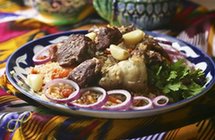跟着主席出访的脚步 看看哈萨克斯坦有啥好吃的
|
6月7日下午,国家主席习近平乘专机离开北京,应哈萨克斯坦共和国总统纳扎尔巴耶夫邀请,对哈萨克斯坦共和国进行国事访问并出席上海合作组织成员国元首理事会第十七次会议和阿斯塔纳专项世博会开幕式。 哈萨克斯坦共和国位于中亚和东欧,国土横跨亚欧两洲,国名取自其最大民族哈萨克族。哈萨克斯坦原为苏联加盟共和国之一,1991年苏联解体后独立,与俄罗斯、中国、乌兹别克、土库曼等国接壤,并与伊朗,阿塞拜疆隔海相望。其国土面积相当庞大,排名世界第九位。 在去年的一档综艺节目中,来自哈萨克斯坦的“进口小哥哥”迪玛希得到众多年轻观众的喜爱。其实,除了拥有好歌喉的艺人之外,哈萨克斯坦的美食也非常值得推荐。 我们的编辑多方搜罗,为大家推荐几款哈萨克风味美食,其中大部分都跟肉有关。“无肉不欢”的同学们,可要看仔细了啊!
The main meal of every dastarkhan and one of the most delicious for Kazakh people was Kazakh style cooked meat. Boiled meat was served in large uncut pieces. The host was cutting the meat himself and treat every guest: pelvic bones and shank for honorable old people, brisket for son-in-law or daughter-in-law, neck-bone for girls and so on. The delicious aromatic meat was eaten with thin boiled pieces of pastry. Excellent addition to this dish was rich flavored meat bouillon - sorpa. Kumiss and tea were the last dishes of the meal. Today Kazakh meal is something different from the old one but still it is imbued with ancient laws of hospitability. On the contrary the hospitability is larger than ever for now because not only Kazakhs but people of various nations (Kazakhstan is a multinational country) have a meal around the dastarkhan: Russians, Ukrainians, Uzbeks, Germans, Koreans and more. All these nations made their contribution on Kazakhs cookery. The assortment of food groceries was changed slightly. During its long history Kazakhstan people gathered a huge experience in cooking dishes from meat and milk. And modern times filled it with a large range of vegetables, fruit, fish, sea stuff, baked, flour dishes and confectionery. But still the most popular Kazakhstan national foodstuff is meat. From olden times Kazakh cookery was special due to its original technology. The traditional national Kazakhstan cookery is based on boiling. Exactly boiling helps to cook meat with a lot of delicate tastes, gives it softness and aroma. Kazakh people placed high emphasis on long-term storage of foodstuff. A huge part of meat was prepared for future use being salted, dried. Delicatessen was cooked mainly from horse meat - kazi, shuzhuk, zhal, zhaya, karta and others. Milk and milk products were widely spread. The preference was for the sour milk products because it was easier to save during nomadic life. Bread was usually made like cookies. The most popular baked dish is baursaki. The ancient plates and dishes were made from leather, wood, ceramics. Every family had cast-iron cauldron (kazan) for cooking. The tea was boiled in cast-iron jugs, later in samovars. Beshbarmak: The national dish of Kazakhstan means ‘five fingers’ referring to the fact that it is eaten by hand. It consists of boiled meat (traditionally horse but nowadays often lamb) and large noodles that look like sheets of lasagne in an onion gravy/broth. Kazy: a traditional sausage made of fattened horsemeat, the fat is very rich and nourishing. The thick coils of black meat look rather unappetizing in the meat chiller cabinets in the supermarket. Kazy is a popular part of any celebratory meal. Manti and Pelmeni: Manti are large steamed dumplings filled with ground meat (usually lamb) served with sour cream. Pelmeni are similar but smaller and sometimes filled with vegetables. Both are very popular with children. They are available in most Kazakh restaurants and are a good bet for a quick, nourishing snack. Lagman: a tasty traditional Uyghur dish of thick noodles served with beef broth, beef and tomatoes, this is popular in local cafes and fast food restaurants. Shashlik: kebabs cooked over a charcoal fire shashlik is traditionally made from lamb or beef but can also be made from chicken or fish (sturgeon is particularly delicious) and served with flatbread. The meat for a good shashlik is marinated overnight and quite distinctively spiced (the spices work well with roast chicken). Shashlik is a common, indeed necessary, part of any picnic barbeque. |









